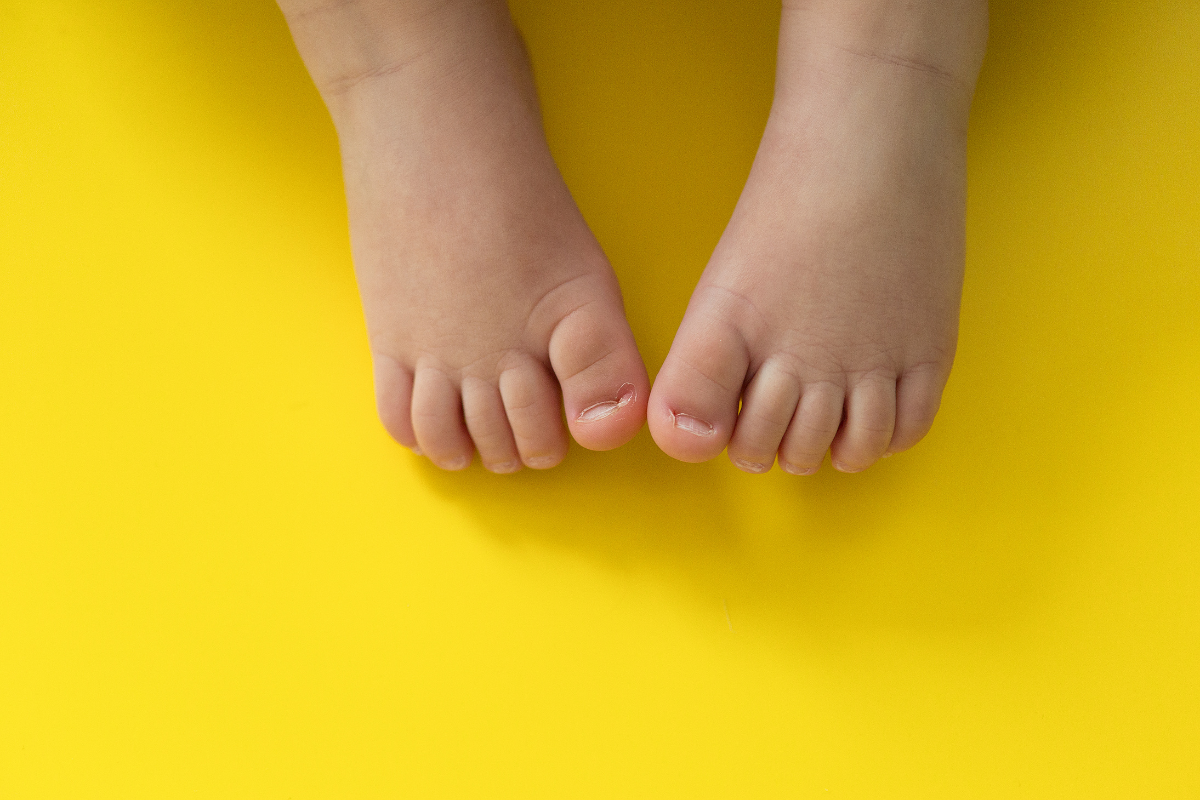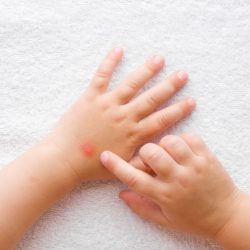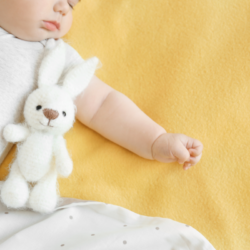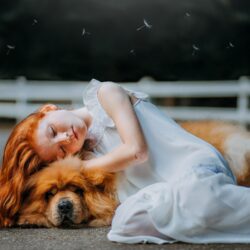Baby’s skin is a real treasure, but also a source of worry for many parents. Who hasn’t been a little panicked to discover sudden redness or small patches after a bath? I’ve been there too. And while some of these little injuries are harmless, it’s essential to recognise them so you can act at the right time and avoid complications. In this article, I offer you some practical advice, simple gestures and a few natural tips for looking after your little one’s fragile skin.
Babies are often prone to various skin conditions because of their delicate, sensitive skin. However, most of these problems can be avoided or easily treated if detected early. In this article, we’ll take a look at the most common skin conditions affecting babies, their causes, symptoms and how to treat them.
Common skin rashes in babies
Rashes are a common problem for babies. Here are some of the most common rashes in infants:
Diaper rash (breech dermatitis) in infants :
Does your baby have a red, irritated bottom? Your child probably has diaper r ash. This condition is very common in infants.
Diaper rash is an irritation of the skin in the area normally covered by nappies. The skin may be slightly red, or cracked and inflamed to the point of infection. Diaper rash can have several causes, but it is most commonly caused by the skin remaining in contact with the baby’s urine and faeces for too long. Bacteria in the stools break down the urine into ammonia, a powerful irritant(these bacteria prefer an alkaline environment; unlike breast-fed babies, bottle-fed babies have alkaline stools, so are more likely to suffer from diaper rash). The skin around the genitals becomes irritated and, if left untreated, pimples can form.
Diaper rash can occur for a variety of reasons: poor absorption of nappies, inadequate wiping after bathing or an allergic reaction to a washing product. Each situation requires special vigilance and a few simple adjustments to relieve baby. This reaction is one of the first signs of a form of eczema known as “baby eczema“. Diaper rash can still occur in the event of illness or diarrhoea. Some children are more prone to this irritation than others.
When it comes to diaper rash in infants, first and foremost, certain rules of hygiene should be observed, to limit skin irritation and even possible superinfection:
- Change your baby’s nappy regularly
- If possible, leave your child’s bottom in the open air for as long as possible
- Avoid nappies that are too tight
- Use soothing plant-based products
Aromatherapy formula for a natural treatment to soothe baby’s red bottom:
From the age of 3 months (i.e. between 4 kg and 7 kg) – Formula to be applied to the bottom at each diaper change:
For 150 ml of lotion :
Roman chamomile hydrolate (37.5 ml) Rose water hydrolate (37.5 ml) Olive oil vegetable oil (50 ml) Sweet almond vegetable oil (25 ml).
In the case of over-infected diaper rash, you can potentiate the formula by adding up to 15 drops of rosewood essential oil (i.e. a dilution rate of 0.5%).
- Roman chamomile :
This hydrosol soothes redness and skin irritation.
- Rose :
Rose water is a skin regenerator and softener that calms redness.
- Olive :
Its oil is nourishing, moisturising and skin-soothing.
- Sweet almond :
Sweet almond oil is soothing, softening and emollient for the skin.
- Rosewood :
Rosewood essential oil is antibacterial, antifungal and skin regenerating.
After the nappy area, another common skin problem is on the scalp: the famous cradle cap. They often worry young parents, but are actually harmless.
Cradle cap (seborrhoeic dermatitis) :
Cradle caps are very common in infants and, despite their impressive appearance, are completely harmless. They look like small yellowish or whitish flakes of skin, sometimes slightly thick, which form on the scalp. These patches are often accompanied by scales, giving the skin a scaly appearance.
Most often found on the top of the head, they can also appear on the eyebrows, behind the ears or even around the nose. They do not cause pain or itching, but they do deserve a little attention to prevent them from thickening further.
How can I take care of cradle cap?
A few simple steps can help to gently reduce them:
- Avoid scratching the scabs, even though it may be tempting. This could irritate the skin or cause a minor infection.
- Wash the scalp daily with a mild shampoo suitable for babies. Massage gently to loosen the flakes without forcing.
- After bathing, dry your baby’s head thoroughly with a soft towel.
- Use a soft bristle brush to gently comb your baby’s hair. This helps to remove flakes without damaging the skin.
With a little patience and regularity, cradle cap usually disappears within a few weeks. If they persist or spread, it’s always a good idea to talk to your paediatrician.
Aromatherapy-based formula for naturally reducing baby’s cradle cap:
From the age of 3 months (i.e. between 4 and 7 kg) – Apply to the scalp in the morning and evening, massaging gently for 1 week.
For 100 ml of lotion :
Rose water hydrolate (35 ml) Sweet almond vegetable oil (65 ml).
In the case of infected cradle caps, you can boost the formula by adding 10 drops of rosewood essential oil (i.e. a dilution rate of 0.5%).
- Rose :
Rose water gently cleanses the skin and calms skin irritations.
- Sweet almond :
Sweet almond oil is soothing, softening and emollient for the skin.
- Rosewood :
Rosewood essential oil is antibacterial and skin regenerating.
Atopic dermatitis
Atopic dermatitis is a chronic inflammatory skin condition that causes dryness and itching. The exact causes are not known, but they are often linked to genetic factors. Symptoms include rashes, itching and irritation. Treatments include the use of moisturisers, topical steroids and antihistamines.
Miliaria
The famous heat rash! These little red spots often appear when baby sweats too much, especially in summer. It’s not serious, but it can be a nuisance. A cool bath and light clothing are usually enough to soothe the skin. Symptoms include redness, itching and pain. Treatment generally involves keeping the area clean and dry, avoiding clothing that is too hot and ensuring good hydration.
Common skin infections in infants
Infants are also prone to skin infections, which can be dangerous if not treated promptly. Here are some of the most common skin infections in infants:
1. Impetigo
Impetigo is a bacterial skin infection that causes blisters, scabs and lesions on the skin. The main causes are staphylococcus and streptococcus bacteria, which can enter the body through a cut, scrape or insect bite. Symptoms include red, painful lesions that can enlarge and spread rapidly. Treatment consists of topical or oral antibiotics prescribed by a doctor.
2. Ecthyma
Ecthyma is a more serious bacterial skin infection than impetigo. It causes deep skin lesions and yellow scabs that can be painful. The main causes are staphylococcus and streptococcus bacteria, which often enter the body through a cut or scrape. Treatment involves oral antibiotics prescribed by a doctor.
3. Candidiasis
Candidiasis is a fungal infection that can affect the skin, mouth and genitals. Infants can contract this infection during childbirth or by touching infected objects. Symptoms include redness, itching and rash. Treatment consists of antifungal creams or oral medication prescribed by a doctor.
4. Molluscum contagiosum
Molluscum contagiosum is a viral infection of the skin that causes small white or pink spots with a depression in the centre. The infection is easily spread by direct contact with infected skin or contaminated objects. Symptoms include painless skin lesions, but treatment is not always necessary as the lesions often disappear on their own.
Monitoring your baby’s skin on a daily basis is essential to identify any small problems early on. The good news is that most skin conditions are not serious and are easily resolved with the right care. However, be careful: some infections can progress and require prompt medical attention. If you have the slightest doubt, or if the symptoms persist, never hesitate to seek advice from a health professional. One precaution too many is better than an underestimated risk for your little one’s fragile skin.
@soin.et.nature 👶✨ Dites adieu aux croûtes de lait naturellement ! 🌿 Découvrez nos 3 astuces magiques dans cette vidéo : 1️⃣ Le duo peigne & brosse NUK pour un massage en douceur 2️⃣ L’hydrolat de rose, un allié apaisant 3️⃣ L’huile d’amande douce, pour nourrir et assouplir le cuir chevelu 🌸 Pour les petits bouts dès 3 mois, optez pour notre formule maison : Mélangez 35 ml d’hydrolat de rose avec 65 ml d’huile d’amande douce et massez délicatement 2 fois par jour pendant 1 semaine. #bébé #croutesdelait #Aroma





